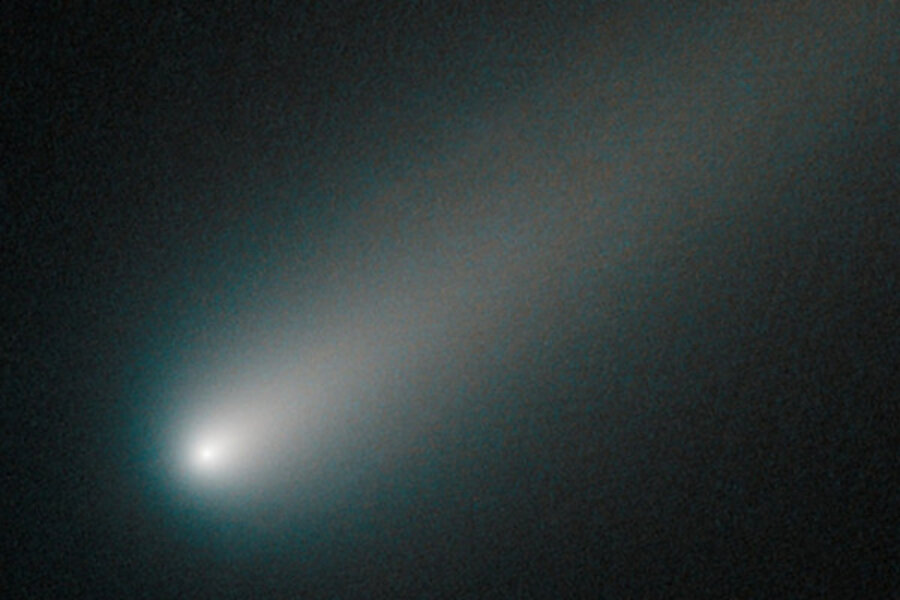Will Comet ISON make it to Christmas? New evidence offers clues.
Loading...
Comet ISON is proving to be a head-scratcher of a comet. When first discovered, it was unusually bright for a comet so far from the sun, prompting "Comet of the Century" rumors. When it failed to live up to its early promise, some wrote it off as a dud.
But ISON is still chugging along toward its rendezvous with the sun, scheduled for Thanksgiving Day (Nov. 28), and nobody knows what will happen.
A new study is looking to the past to predict the future. To evaluate Comet ISON's prospects, one expert with five decades of comet-watching experience is comparing ISON to two historical comets: Seki-Lines and Hoenig. Like ISON, these were "new" comets, freshly perturbed from the Oort Cloud and heading in for their first (and only) trip around the sun.
Based on his comparison, ISON probably won't give the dazzling show that was hyped a few months ago, says Zdenek Sekanina, the principal scientist with NASA's Earth and Space Sciences Division.
"The trends, at the moment, are certainly not in favor of a spectacular comet," he says, though he acknowledges that comet predictions are a tricky business.
ISON will not be the closest comet ever to graze the sun – in fact, thousands of comets have come closer – but it is the closest "new" comet ever measured. At its closest approach, ISON will be barely a million miles from the surface of the sun.
In 1962 Comet Seki-Lines, the current record holder for the closest "new" comet, got within 3 million miles of the sun, and it survived. In 2002, Comet Hoenig was over 70 million miles away when it disintegrated.
"These are similar comets, as far as their origin is concerned, yet they behaved very differently," says Sekanina.
Seki-Lines and Hoenig present "extreme cases," he explains, mapping out best-case and worst-case scenarios for ISON. Sekanina is comparing the comets by measuring how brightly they shine while approaching the sun. In 1962, Seki-Lines got slowly but steadily brighter, while in 2002 Hoenig brightened quickly, leveled off, and then disintegrated.
At first, ISON looked like it was following Seki-Lines's example, growing steadily brighter. But then, in recent weeks, ISON's brightness has hit a plateau, like the doomed Hoenig. The most recent data "are almost at the point where [Hoenig] fizzled out," says Sekanina.
But don't rush to judgment. "You can't automatically conclude ISON is going to fizzle out," he says. "It depends on what happens next."
Comets constantly lose material from their nucleus, as frozen gases vaporize and as dust particles are knocked free by the sun's radiation. These create the comet's coma (glowing head) and eventually are pushed back into its tail. For ISON to stay at a constant brightness means that new material is being released from the nucleus at almost exactly the same rate as it is being lost to the tail or into space.
"The comet is active, but it's just barely replacing whatever gas and dust are lost," says Sekanina. "Both are replaced just at the minimum rate for the comet to survive – for now." Once the rate of loss outstrips the rate of replacement, the comet is doomed.
"At the moment, [ISON] is still surviving, but it is brightening, at a very, very slow pace," says Sekanina.
But don't give up hope of a dazzling light-show just yet. ISON may have one last ace up its sleeve.
The most recent image from the Hubble space telescope show no jets of gas, writes Josh Sokol, a member of Hubble's ISONblog team. "Without a jet to spin it around (see: WALL-E & Gravity, 'fire extinguisher') ISON likely isn’t rotating much. This suggests an exciting potential future: Perhaps there’s a 'dark' side of ISON, which won’t have ever seen the light of day until the comet goes around the Sun. If such pristine material still exists, ISON may become more active than we currently expect."
Sizzle or fizzle? Stay tuned.








